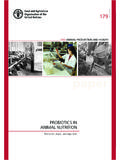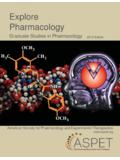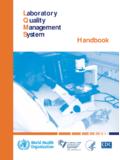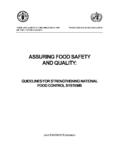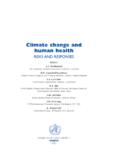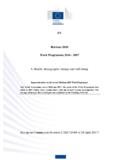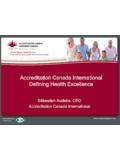Transcription of Conservation” and guidelines - Food and …
1 ISSN 1810-0708. 12. FAO animal PRODUCTION AND health . guidelines CRYOCONSERVATION OF. animal GENETIC RESOURCES. 12. FAO animal PRODUCTION AND health . guidelines CRYOCONSERVATION OF. animal GENETIC RESOURCES. FOOD AND AGRICULTURE ORGANIZATION OF THE UNITED NATIONS. Rome, 2012. Recommended citation FAO. 2012. Cryoconservation of animal genetic resources. FAO animal Production and health guidelines No. 12. Rome. The designations employed and the presentation of material in this information product do not imply the expression of any opinion whatsoever on the part of the Food and Agriculture Organization of the United Nations (FAO) concerning the legal or development status of any country, territory, city or area or of its authorities, or concerning the delimitation of its frontiers or boundaries.
2 The mention of specific companies or products of manufacturers, whether or not these have been patented, does not imply that these have been endorsed or recommended by FAO in preference to others of a similar nature that are not mentioned. The views expressed in this information product are those of the author(s) and do not necessarily reflect the views of FAO. ISBN 978-92-5-107306-3. All rights reserved. FAO encourages reproduction and dissemination of material in this information product. Non-commercial uses will be authorized free of charge, upon request. Reproduction for resale or other commercial purposes, including educational purposes, may incur fees.
3 Applications for permission to reproduce or disseminate FAO copyright materials, and all queries concerning rights and licences, should be addressed by e-mail to or to the Chief, Publishing Policy and Support Branch, Office of Knowledge Exchange, Research and Extension, FAO, Viale delle Terme di Caracalla, 00153 Rome, Italy. FAO 2012. iii Content Foreword ix Acknowledgements xi The goal and structure of the guidelines xiii Abbreviations and acronyms xv Section 1. Confirming the decision to cryoconserve 1. In situ conservation 3. Ex situ conservation 4. Complementary roles of in situ and ex situ conservation 4.
4 When is cryoconservation the best option? 5. Section 2. Implementation and organization 7. Shaping national strategies and action plans 9. Organization and institutions 9. Participation of stakeholders 10. Funding and attracting support for projects 12. Section 3. Objectives of cryoconservation programmes 13. Gene banking 15. Collection goals 17. Collection categories 20. Utilizing the working collection 22. Refreshing the collections 23. Section 4. Potential use of different types of germplasm and tissue 25. Semen 28. Embryos 29. Oocytes 31. Somatic cells 32. Cryopreservation of DNA for genetic analyses 34.
5 Choosing the genetic material to store 34. Advanced procedures and their curent potential in cryoconservation 35. Future prospects for cryoconservation 38. iv Section 5. Establishing a gene bank physical structure and costs 43. The physical plant 45. Size and capacity requirements for gene banks 53. Recommended equipment and estimated costs 55. Gene bank security 55. Centralization and accessibility 56. Human resources 58. Continuity of operations 58. Section 6. Developing gene bank collections 61. Choice of populations to include in the gene bank 63. Collection targets for reconstituting populations 66.
6 Utilization of gene bank material in live conservation and breeding 75. Selection of individuals for cryopreservation 77. Collection of complementary biological material 80. Section 7. Basic principles of cryopreservation 83. Slow freezing 85. Vitrification 91. Freeze drying 93. Section 8. Collection of germplasm and tissues 95. Semen 97. Embryos 100. Oocytes 109. Somatic cells 114. Section 9. Sanitary recommendations 117. Collection and processing facility 120. Field collection 120. Disease testing 121. Storing samples 121. Section 10. Database and documentation 123. Components of a gene bank information system 125.
7 Database information set 126. v Section 11. Legal issues contracts and access 131. Structure for handling agreements 133. Acquiring germplasm 134. Access to the gene bank's collection 135. International transfers of germplasm 137. Section 12. Capacity building and training 139. References and appendices 143. References 145. Appendix A: Specialized procedures for field collection of germplasm 161. Appendix B: List of equipment needed for semen collection and freezing 163. Appendix C: Procedures for cryopreservation and thawing of semen from common livestock species 165. Appendix D: guidelines for basic semen analysis 175.
8 Appendix E: Commonly used superovulation schemes for donor cattle embryo recovery 177. Appendix F: List of equipment and supplies needed for non-surgical embryo collection and transfer in cattle 179. Appendix G: Technical procedures for cryopreservation and thawing of livestock embryos 181. Appendix H: Bovine oocyte collection procedures 185. Appendix I: In vitro maturation of bovine oocytes 189. Appendix J: Bovine in vitro fertilization protocol 191. Appendix K: Harvesting tissue samples for cryoconservation of somatic cells 197. Appendix L: Collection and freezing of poultry gonadal tissue 201. Appendix M: References for the appendices 203.
9 Vi boxes 1 Maintaining genetic diversity 16. 2 Viability of germplasm after long-term storage 22. 3 Cryobanking of somatic cells in Viet Nam 33. 4 Example animal holding and collection facility 48. 5 Liquid nitrogen safety 53. 6 Liquid nitrogen tanks 56. 7 Use of gene bank semen for revival and support of the breeding programme of the endangered Dutch Friesian Red and White cattle breed 76. 8 Reconstituting a research pig line 77. 9 Using frozen biological material from at-risk breeds: discrepancy between theory and practice 78. 10 Selection of bulls for the National animal Germplasm Program in the United States of America 80.
10 Tables 1 Conservation techniques and objectives 5. 2 Comparison of non-surgical and surgical artificial insemination in livestock when using frozen thawed semen 29. 3 Non-surgical versus surgical embryo collection 30. 4 Non-surgical versus surgical embryo transplantation by species 31. 5 An overview of some characteristics of several ways to cryoconserve genetic material 35. 6 Estimated equipment costs by gene bank size 57. 7 Number of semen doses required to reconstitute a breed of cattle, small ruminant or horse 69. 8 Number of doses per male required to reconstitute a breed of cattle, small ruminant or horse 69.










